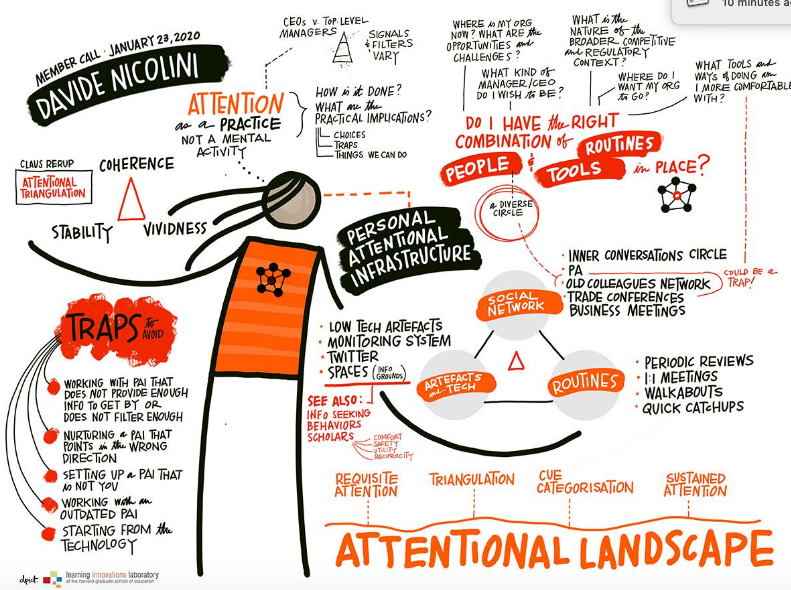
The January 2020 member call featured the work by Davide Nicolini, Warwick Business School. This is a summary of the ideas he shared with LILA members.
Where We’ve Been
Over the course of this year, we’ve considered how what we know may be less important than how we are connected to ongoing knowing. Being in the flow of information is critical – yet how can we thoughtfully attend to ‘ongoing knowing’ without being overwhelmed by information?
Learning and Attention Triangulation
Claus Rerup presented a framework to the LILA Community a year ago. This Learning and Attention Triangulation framework connects three processes: attention coherence, attention stability, and attention vividness.

OK, great – but how do we do it?
Professor Nicolini studies how senior leaders ‘do attention’. Executives are flooded with issues and information, yet successful leaders can ‘keep on top’. How do senior leaders strike an appropriate balance between being in the know and feeling subsumed by information? Are their challenges different from those of mid level managers?
Nicolini and his colleagues studied 70 executives in large hospitals across the UK. Hospitals are complex systems and offered a realistic way to consider how leaders organize their attention in the face of massive information and decisions.
Some of the findings
All CEOs deploy routines, relationships, and artifacts/technologies as part of their Personal Attention Infrastructure (PAI).
Routines – Leaders develop their own authentic routines to stay in the know without being in the weeds. Examples include one to one meetings, walkabouts, spending time on the ‘front line’, and coffee catch-up meetings (getting info from certain sources).
Relationships/Social Networks – Leaders gather and filter information through carefully curated relationships. This can include old colleagues network, an ‘inner conversations’ circle, professional associations and trade conferences, and business meetings to collect information. Importantly, these leaders don’t value all connections equally.
Artifacts and Technologies – Leaders utilize a variety of technologies, ranging from the low tech – email filters and open-door office policies – to internal monitoring systems to organize news and Twitter feeds. Leaders also leverage spaces and information grounds to gather and share relevant information.
The Whole is Greater than the Sum of its Parts
The ‘trick’ to a strong Personal Attention Infrastructure, Nicolini found, was deploying all three elements – routines, relationships, and artifacts – consistently. Alone, these components seem simple and powerless, but taken together, they create a robust attention infrastructure.
These seemingly mundane set of habits deserve intentionality. A personal attention infrastructure helps to categorize information into important/not important categories, helps to sustain attention over time, and helps maintain ‘requisite attention’ on important issues.
PAIs are highly personalized
Leaders’ personal attention infrastructures are influenced by a variety of factors: personal experience, tenure, the surrounding executive team and board, conditions and norms of organizational environment, technologies available, strategic vision, perceived economic, competitive and regulatory environment, and what kind of manager they want to be.
Traps to Avoid
- PAI that isn’t in the ‘Goldilocks zone’: filters out too much information, or doesn’t allow for enough information to make informed decisions.
- PAI that ‘points in the wrong direction’: overly granular and detailed
- PAI that is not authentic
- PAI that is outdated for your context
- PAI that is based on technology, rather than needs
Developing the capacity to stay in the Know: A Framework for Reflection

How do I Develop my Personal Attention Infrastructure?
- Take stock of your current situation
- Do it with others! Get a coach to observe you, or employ peer group for comparison and learning
- Develop a personal plan to rebuild and/or enhance your personal attention infrastructure
- Reflect on composition of your ‘inner circle’. Do your close confidants challenge your perspectives and help expose you to alternative ideas?
- Reflect often!
Our attention infrastructures are often taken for granted; they seem second nature and implicit. However, they require careful intentionality in order to make sure that they are authentic and evolving based on context.
Questions for the LILA community to consider:
- Do you recognize Personal Attention Infrastructures in your working life?
- Do you see PAIs at various levels and positions in your organizations, beyond executive leadership?
- What are you doing to make sure that you’re in the know? What practices do you have to help you focus your attention?
- Do I have the right combination of people, tools and routines to support my Personal Attention Infrastructure?
To read the original article from which these ideas were drawn published in MIT Sloan Review by Davide Nicolini click here: “Staying in the Know.”
To read a summary of the presentation shared by Claus Rerup on Attention Triangulation, click here (You must be signed into the LILA website to a

Add a comment